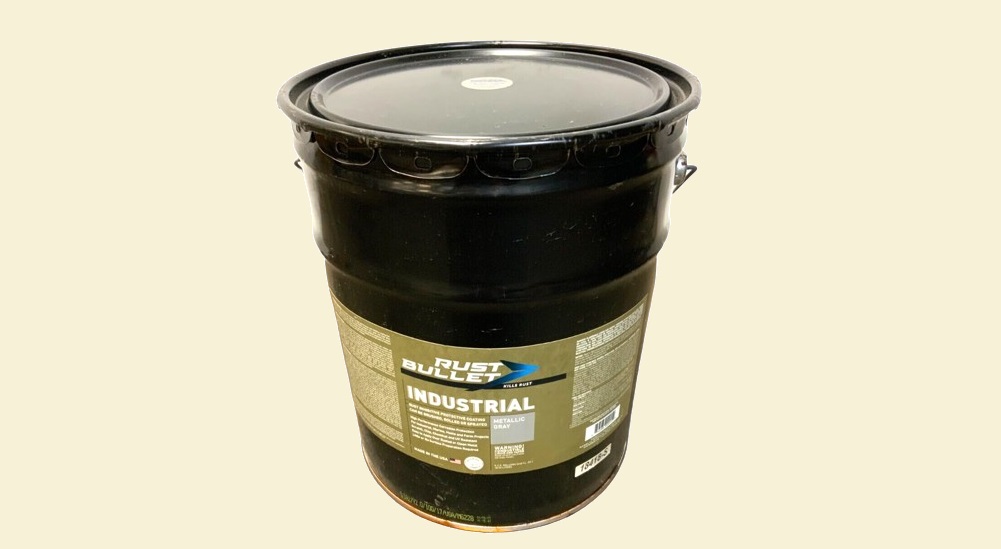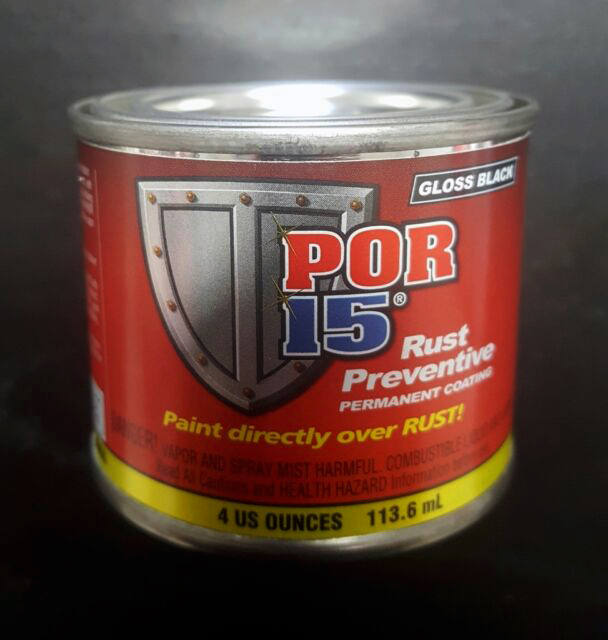When protecting your vehicle from the relentless assault of rust, the stakes are high, and the solutions must be effective.
Two heavy hitters in this arena are Rust Bullet and POR-15. Each product offers a robust solution to combat rust, but they go about it differently, making it vital to understand their unique properties and applications.
Whether you’re a seasoned auto restorer or simply looking to extend the life of your car, choosing the right rust-prevention product can make all the difference.

Table of Contents
Rust Bullet
Rust Bullet is famous for its straightforward application process and its ability to prevent and treat existing rust.
Unlike traditional rust converters, which require rust presence, Rust Bullet is a preventative layer that can be applied directly over rusted or clean surfaces. It claims to stop rust through a unique formulation.
POR-15
On the other hand, POR-15 stands out with its moisture-curing process, which makes it highly effective in moist environments.
POR-15 is designed to be applied directly to rusted surfaces, forming a hard, non-porous coating resistant to many forms of chemical attack.
This makes it particularly valuable in harsh environments where chemicals and moisture combine to accelerate corrosion.
1. Chemical Composition and Properties
Rust Bullet
Chemical Composition and Active Ingredients
Rust Bullet is distinct in its formulation, primarily based on urethane alkyd resins and incorporating metallic zinc for added protection.
This combination provides a rigid physical barrier against external elements and promotes adhesion to various surfaces without a primer.
Rust Inhibition Mechanism
The mechanism behind Rust Bullet’s rust inhibition lies in its ability to form a dense, impermeable layer that oxygen and moisture cannot penetrate.
When applied, it reacts with existing rust to form a chemical bond, encapsulating and preventing rust from spreading further. This “sealing” effect halts oxidation, the primary cause of further rusting.
POR-15
Chemical Composition and Active Ingredients
POR-15’s formulation is heavily based on polyurethane enhanced with additional polymers designed for maximum durability and resistance to corrosive substances.
Its active ingredients include a complex blend of silicates that enhance its moisture-curing properties, making it particularly effective in damp environments.
Rust Inhibition Mechanism
Unlike typical paint, POR-15 does not just cover rust; it uses the moisture present in rust to cure and harden, thus ensuring a chemical and mechanical bond.
The hardened surface effectively isolates the metal from further exposure to elements that contribute to corrosion, such as water, salt, and other chemicals.

2. Application Process
Rust Bullet
Surface Preparation Requirements
One key advantage of Rust Bullet is its minimal surface preparation needs. Unlike many rust treatment products that require extensive rust removal and surface priming, Rust Bullet can be applied directly over rusted or clean surfaces.
The only necessary preparation is removing loose rust with a wire brush and ensuring the surface is free of grease, oil, and dirt.
Application Steps and Recommended Tools
Applying Rust Bullet is straightforward:
1. Clean the Surface: Ensure the surface is free from contaminants.
2. Apply the Coating: Use a brush, roller, or spray equipment to apply Rust Bullet. It typically requires two coats for optimal performance, with the second coat applied after the first has become touch dry, approximately 2-4 hours later.
3. Curing: Allow 48-72 hours for full curing under normal conditions.
POR-15
Surface Preparation Requirements
POR-15 requires more rigorous surface preparation to ensure its effectiveness. The surface must be free of loose rust and debris and etched to provide a tooth’ for better adhesion.
POR-15 recommends using their own specific cleaning and etching products to achieve the best results.
Application Steps and Recommended Tools
The application process for POR-15 is more involved:
1. Clean and Etch the Surface: Thoroughly clean the surface with POR-15 Cleaner Degreaser, then apply POR-15 Metal Prep to etch the surface.
2. Apply POR-15 Rust Preventive Coating: Apply the first coat using brushes or sprayers designed for use with solvent-based paints. Two coats are recommended for the best results.
3. Curing: POR-15 cures with exposure to moisture in the air. While it becomes tack-free in 2-5 hours, it requires about 48 hours to fully cure.
3. Curing and Environmental Conditions
Rust Bullet
Curing Time and Conditions
Rust Bullet’s curing process is relatively straightforward. Under typical environmental conditions, it dries to touch within 2-4 hours and requires about 48-72 hours to fully cure.
This curing time can vary based on temperature and humidity, with warmer and drier conditions accelerating the process.
Environmental Factors Impact on Curing
Rust Bullet is versatile in its curing capabilities but performs best in temperatures between 50°F and 80°F (10°C and 27°C).
High humidity can extend the drying time, whereas extremely low temperatures may require additional time or heat to ensure proper curing.
Applying Rust Bullet when rain or heavy dew isn’t expected within the curing period is essential to prevent surface imperfections.
POR-15
Curing Time and Conditions
POR-15 cures differently, relying on the moisture in the air to harden. It becomes tack-free in 2-5 hours and reaches full cure within 48 hours. This moisture-curing feature is particularly advantageous in environments naturally high in humidity.
Environmental Factors Impact on Curing
Environmental conditions play a critical role in the effectiveness of POR-15’s curing process. Ideal conditions include moderate to high humidity, which facilitates a quicker cure.
In contrast, very dry conditions can slow the curing process, potentially requiring a humidity generator or waiting for a more suitable day.
Cold temperatures below 50°F (10°C) also hinder the curing process, necessitating a heated environment to maintain optimal curing conditions.
4. Durability and Performance
Rust Bullet
Longevity under Typical Use Conditions
Rust Bullet is designed for longevity, providing a durable layer that withstands general wear and tear for years.
It’s particularly effective in automotive applications, where it can prevent rust for up to 10 years under normal conditions.
This durability is due to its robust formulation, which remains effective even under fluctuating environmental conditions.
Performance in Various Climates and Exposures
Rust Bullet’s performance is consistent across various climates, from dry to wet and salty environments.
Its ability to seal the surface from moisture and oxygen makes it an excellent choice for coastal areas where salt spray is prevalent.
Also, Rust Bullet maintains its integrity in regions with extreme temperature variations, resisting cracking and peeling.
POR-15
Longevity under Typical Use Conditions
POR-15 excels in scenarios where rust is already present, sealing it off and preventing further corrosion.
It is renowned for its ability to last for decades without peeling or cracking, provided it is not exposed to UV light, which can degrade its effectiveness unless a top coat is applied.
Performance in Various Climates and Exposures
POR-15’s performance is highly dependable in humid and marine environments, where its moisture-curing properties become an advantage.
It forms a rigid, impermeable barrier extremely resistant to salt, chemicals, and other corrosive elements, making it ideal for vehicles and structures in harsh environments.
However, POR-15’s curing process may require additional steps to ensure optimal adhesion and effectiveness in dry climates.
5. Cost-Efficiency and Value
Rust Bullet
Cost per Unit and Coverage Area
Rust Bullet is generally available in various sizes, from small project containers to extensive industrial-sized options, making it adaptable for different project scopes.
The cost per square foot can vary depending on the purchase size and retailer. Still, considering its long-term rust prevention capabilities, it is typically considered a moderate investment.
Overall Value Considering Durability and Performance
The value proposition of Rust Bullet lies in its long-lasting protection and the minimal preparation required before application.
This reduces labor costs and additional material expenses, such as primers or top coats, unless under extreme UV exposure conditions.
For many users, the balance between upfront costs and the extended lifespan of the protected surfaces justifies the investment, making Rust Bullet a cost-effective solution for small-scale DIY projects and large-scale industrial applications.
POR-15
Cost per Unit and Coverage Area
POR-15 tends to be pricier per unit than many competitors, including Rust Bullet. However, its coverage area is highly efficient, with a little going a long way due to its thick, sealing nature.
The need for pre-application treatments like degreasers and metal prep solutions should be considered as part of the overall cost.
Overall Value Considering Durability and Performance
POR-15’s higher initial cost is often offset by its exceptional durability and specific benefits in preventing and stopping rust progression.
Its performance in challenging environments where moisture and corrosive chemicals are present makes it invaluable for protecting valuable equipment, vehicles, and structures.
For users in such conditions, the cost is seen as an investment in long-term protection, avoiding more frequent repairs or replacements.
Conclusion
In summary, Rust Bullet and POR-15 offer practical solutions for rust prevention, each with unique strengths. Rust Bullet is user-friendly, requires minimal surface prep, and offers lasting protection across various environments.
POR-15 excels in particularly harsh, moisture-rich conditions, providing a durable barrier against corrosion at a higher initial cost.
Choosing the right product depends on specific project requirements, environmental factors, and budget, ensuring the best protection for your valuable assets against rust.
